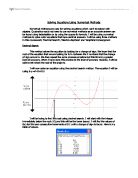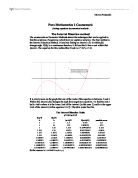Solving Equations by numerical methods.
The fact that the vast majority of the numbers on the real number line are irrational (i.e. cannot be put in the form p/q, where p and q are integers) has an associated consequence that the vast majority of equations involving powers of x (i.e. polynomials) are insoluble by closed analytical techniques.
This coursework's solution implies finding values of x say c1, c2-...c3 where f(c1)=0; f(c2)=0 and so on. Further transcendental equations and non- linear equations require numerical methods for their solution. It is to be noted that in no way are numerical methods inferior to analytical solutions, they are indeed the only practical solutions available, however on the down side no exact solution is possible and error bounds have to be placed on the solution given.
In this coursework three main methods of solution from one-dimensional equations are given, each of the methods could be extended to the multi-dimensional case. The aim of this coursework is to show example of the methods in action, where these are successful and where they are not. A comparison between the methods will also be attempted.
Method 1: Decimal Search
SOLVING AN EQUATION WITH THIS METHOD
Fig1. Shows the function f(x) = 12 ln(x) - x3/2. (Where ln(x) represents the natural logarithm of x.)
To find the roots, the equation is:
2 ln(x) - x3/2 = 0
This equation can not be solved numerically because x appears inside the function ln(x) as well as in a power term. Therefore we can not find the inverse function and isolate x.
This comparatively innocuous looking function crosses the x-axis at some point around the interval [1, 2] and again at some point around the interval [8, 9]. For small values of x the term 12ln(x) dominates and is large and negative. For larger values of x the term x3/2 dominates and is large and positive, making the f(x) value large and negative.
My centre of interest lies within the range 0<=x<=4. I will use the Change of Sign Method to find an estimate for the first root, which works by seeing if f(x) crosses the x-axis and hence causing a change of sign.
WHEN THE DECIMAL SEARCH METHOD DOESN'T WORK!
This method will not work if:
* There is no sketch available, without one we cannot determine intervals for the root to lie within
The fact that the vast majority of the numbers on the real number line are irrational (i.e. cannot be put in the form p/q, where p and q are integers) has an associated consequence that the vast majority of equations involving powers of x (i.e. polynomials) are insoluble by closed analytical techniques.
This coursework's solution implies finding values of x say c1, c2-...c3 where f(c1)=0; f(c2)=0 and so on. Further transcendental equations and non- linear equations require numerical methods for their solution. It is to be noted that in no way are numerical methods inferior to analytical solutions, they are indeed the only practical solutions available, however on the down side no exact solution is possible and error bounds have to be placed on the solution given.
In this coursework three main methods of solution from one-dimensional equations are given, each of the methods could be extended to the multi-dimensional case. The aim of this coursework is to show example of the methods in action, where these are successful and where they are not. A comparison between the methods will also be attempted.
Method 1: Decimal Search
SOLVING AN EQUATION WITH THIS METHOD
Fig1. Shows the function f(x) = 12 ln(x) - x3/2. (Where ln(x) represents the natural logarithm of x.)
To find the roots, the equation is:
2 ln(x) - x3/2 = 0
This equation can not be solved numerically because x appears inside the function ln(x) as well as in a power term. Therefore we can not find the inverse function and isolate x.
This comparatively innocuous looking function crosses the x-axis at some point around the interval [1, 2] and again at some point around the interval [8, 9]. For small values of x the term 12ln(x) dominates and is large and negative. For larger values of x the term x3/2 dominates and is large and positive, making the f(x) value large and negative.
My centre of interest lies within the range 0<=x<=4. I will use the Change of Sign Method to find an estimate for the first root, which works by seeing if f(x) crosses the x-axis and hence causing a change of sign.
WHEN THE DECIMAL SEARCH METHOD DOESN'T WORK!
This method will not work if:
* There is no sketch available, without one we cannot determine intervals for the root to lie within







